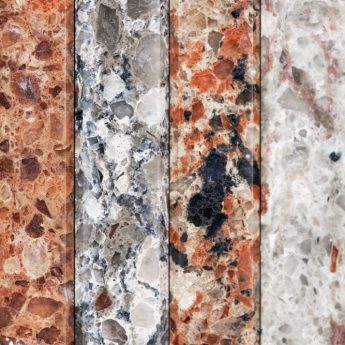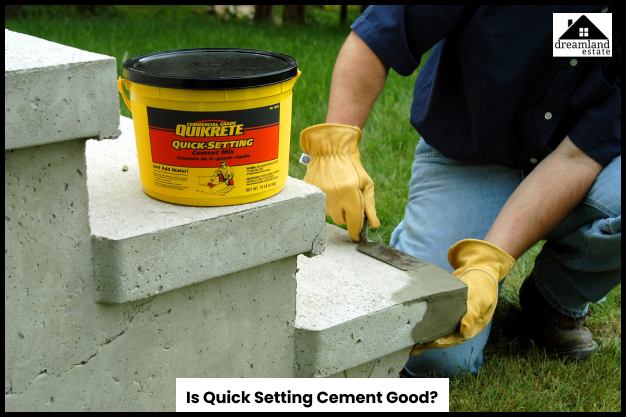What Is Quick Setting Cement? – Uses, Pros & Cons, Applications, and More

A popular type of cement, quick-setting cement, has a set time between five to thirty minutes on average. However, if you have no idea about how cement usually works, especially if you are in the process of building your own house soon, it’s better to do thorough research on construction terminology.
Keep reading to find out what is quick-setting cement and whether it is an excellent decision to use it for construction!
Read More: What Is Low Heat Cement? Is It Good To Use?
What Is Quick-Setting Cement?
Quick-setting cement is a kind of cement with a setting time between 5 to 30 minutes, used primarily for special situations during construction, like constantly in the case of running water. Compared to conventional cement formulations, quick-setting ones are made from a unique formula that decreases the waiting time while increasing the compressive strength.
Although this cement formulation is able to get rid of its plasticity faster than ordinary Portland cement yet, it fails to get hold of an increasing rate of power or strength. Made from well-grinded clinkers of cement, the number of quick-setting cement uses are many in the world of construction.
Advantages Of Using Quick-Setting Cement:
The benefits of using quick-setting cement like ultratech quick-setting cement are as follows,
- Firstly, quick-setting formulation of cement is often used for repairing concrete construction structures because this cement does not disturb the form in any way.
- Although the setting time for quick-setting cement is lesser than ordinary Portland cement, the final strength obtained in the case of both is very similar.
- Thirdly, the reason why this cement formulation is often used for constructions involving running water is due to its high-resistance capabilities to water.
- Lastly, the quantity of water needed during the process of hydration is also low in the case of a quick-setting formulation.
Disadvantages Of Using Quick-Setting Cement:
The cons of using quick-setting cement like ultratech quick-setting cement are as follows,
- Quick-setting cement contains aluminum sulfate. Due to the high content of sulfates in the formulation, not only is durability negatively impacted, but also the risk of sulfate attack prevails.
- When water is added to this type of cement, it is mandatory to complete the work quickly because with increasing time, it becomes challenging to both sets and mixes the cement.
- If you don’t get rid of the heat in your cement, there might be cracks in the cement after the process of setting has been completed.
- Lastly, quick-setting cement is not readily available in the market, and on top of that, whatever is known, is quite pricey.
Uses Of Quick-Setting Cement:
The uses of quick-setting cement are as follows,
- The quick-setting formulation of cement can be used for any underwater construction.
- The quick-setting formulation of cement is also used for constructions in both cold and rainy areas where quick strength is required over a short time period.
- Thirdly, it can be used in areas experiencing high-temperature conditions where water evaporates rapidly.
- Quick-setting cement is also used for fixing steps made from concrete.
- Lastly, quick- setting formulation of cement is used for anchoring rock bolts inside tunnels and other similar underground structures.
You May Like To Read This: 5 Effective Strategies to Improve Construction Site Security
Basically, quick-setting cement is used when quick setting is required. You can get it by adding a small percentage of aluminum sulfate and then finely grinding it to become cement. Furthermore, for the quick-setting action to take place, the cement mixture also contains a small percentage of gypsum and retarder. Here, the addition of the aluminum sulfate helps accelerate the setting fast. Basically, when you mix quick-setting cement with water, it sets in five minutes. Within 30 minutes, you will find it becoming hard like stone. The following are some of the major properties of quick-setting cement that make it a better choice for construction: The following are some of the major applications of quick-setting cement that you need to know: Regular cement takes hours to set and becomes hard. Hence, it is not the ideal option if you want faster construction and repairs. If you need a speedy fix, the best option for you to consider is quick-setting cement. For example, quick-setting cement helps a lot in repairing cracked floors, roads, bridges, building repairs, etc. Due to the lack of density and the washout effect of water, it is hard for regular cement to properly settle underwater. However, with quick-setting cement, performing repairs and construction below the waterline is much easier to do. When the temperature is on the lower side, it takes a longer time for regular cement to set in. However, since quick-setting cement sets faster, it is a great option for construction projects that happen in cold weather. It is also a great option for building foundations of buildings and slabs. If you need faster construction, there is hardly any better option than quick-setting cement. It also helps in the construction of prefabricated concrete. The fast-curing properties of quick-setting cement make it a valuable option for applications in anchoring and grouting. Furthermore, when you are installing bolts, dowels, and other fasteners in concrete, the best thing to use is quick-setting cement. Moreover, rapid setting also helps in the grouting process. What are the Major Properties of Quick-Setting Cement?
Major Applications of Quick-Setting Cement
Fast Repairs
Underwater Construction
Cold Weather Work
Rapid Set Applications
Grouting and Securing
The Quick Cement Phenomenon: Is It Good To Use?
As the name of the cement is indicative, quick-setting cement is commonly utilized for construction whenever a situation of a fast-setting process is necessary. Quick setting cement is produced by adding a tiny portion of alumina to delicately ground clinkers of cement and, in the prodess, decreasing the quantity of calcium sulfate or gypsum.
The grinded clinkers combined with the aluminum sulfate are responsible for speeding up the cement setting time. As a result, quick-setting cement has a very fast setting time compared to ordinary Portland cement.
It is the aluminum sulfate that is responsible in turn for speeding up the hydration rate of tricalcium silicate (C3S) and Tricalcium aluminate (C3A) in the cement – this subsequently leads to the development of strength and fast evolution of heat. Thus, aluminum sulfate is a catalyst in the hydration process of Tricalcium silicate (C3S) and Tricalcium aluminate (C3A).
The cement’s usage, of course, depends on your requirement and also to an extent on your budget and the cement’s availability. But, of course, it is suitable for use where you know that the work will happen quickly since the setting time is between 5 to 30 minutes on average. Also, keep in mind that it’s challenging to find and expensive to buy.
Frequently Asked Questions (FAQs):
1. What Is The Quick-Setting Cement?
It is a particular type of cement formula that can develop strength of compression extremely fast and decreases the cement setting time significantly, compared to traditional types of cement available in the market. It is made by adding alumina to ground cement clinkers and removing a small amount of gypsum.
2. What Is Quick Cement Used For?
It is used for the following situations,
- Constructions that are underwater
- Rainy or cold weather conditions
- Situations where rapid bouts of strength are required within a short time period
- Areas experiencing a high temperature where water can evaporate quickly
3. What Are The Properties Of Quick-Setting Cement?
The properties of quick-setting cement are as follows,
- Resistance towards water is high
- The quantity of required water for hydration is low
- The setting time is less, and the final strength is high
4. How Do You Make Concrete Set Faster?
When you choose to use concrete that sets quickly, you must remember to add water to the pre-mix of cement. It is not as simple as it sounds. This is because the pre-mix of fast-setting cement often gets exposed to outside elements while it is being delivered to the shops. In case the pre-mix comes in contact with rain or humidity for too long, it will start setting.
Conclusion:
Quick-setting cement is one of construction’s gifts to humanity since it sets so fast, making it a convenient choice for people who can afford it. As mentioned before, this type of cement formulation is a perfect choice for any underwater constructions or for constructions in areas of rain and cold.
Additionally, in case you need to quickly get some repair work done, you can always count on quick-setting cement. Again, this is because the formulation in the cement is perfect for any construction that needs to be executed within a short span of time. Thus, you can always opt for this magic cement when you are running really short on time!
Read Also:
- 4 Repairs To Make Before Selling Your Home
- What Is Rapid Hardening Cement? Is It Good To Use?
- Decking With Roof – What Is It? When Should I Replace It?















All Comments
Roehrs
12th Aug, 2023
I think this is a real great article post.Really thank you!
Reply